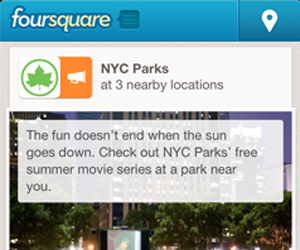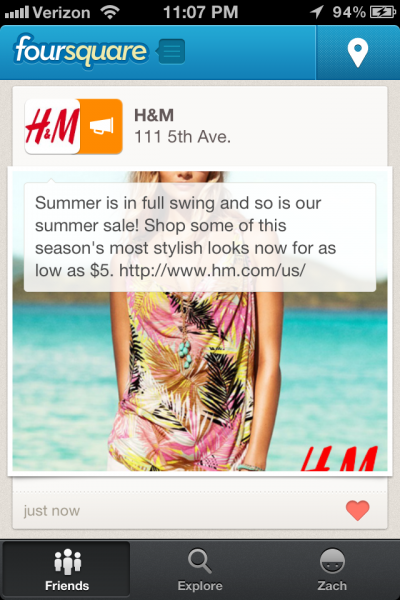 Local merchants that’ve ignored location-based check-in platform foursquare have just been handed a serious reason to get on board: Local Updates, the first-ever way for merchants large and small (all one million of them, currently) to communicate directly with their customers on the platform, has arrived. As of today, they’ve even begun testing the waters with Promoted Updates, a way for a business to attract new customers through paid placement (the difference: spots, matched relative to interests and activity, are only seen when you’re actively searching on the Explore tab). This, coming a month into foursquare’s strategic shift in approach—including a rebuilt mobile app (try it out if you’ve written FS off)—means that the newfound focus for the platform as a social-exploration tool is as much about enabling richer user-to-user interactions as about enabling richer business-to-customer and customer-to-business interactions.
Local merchants that’ve ignored location-based check-in platform foursquare have just been handed a serious reason to get on board: Local Updates, the first-ever way for merchants large and small (all one million of them, currently) to communicate directly with their customers on the platform, has arrived. As of today, they’ve even begun testing the waters with Promoted Updates, a way for a business to attract new customers through paid placement (the difference: spots, matched relative to interests and activity, are only seen when you’re actively searching on the Explore tab). This, coming a month into foursquare’s strategic shift in approach—including a rebuilt mobile app (try it out if you’ve written FS off)—means that the newfound focus for the platform as a social-exploration tool is as much about enabling richer user-to-user interactions as about enabling richer business-to-customer and customer-to-business interactions.
Until now, brands that have had a presence on foursquare were able to engage only from the sidelines, by planting tips and offering static deals and discounts. The proliferation of daily deal sites may merely have been a modest first step toward the local, contextual future of advertising. Now that a when-it-matters, permission-based, content-oriented solution is being pieced together by foursquare, is the market for geolocation advertising primed to explode?
All About Merchants
So why the concerted push by foursquare for more merchant involvement? As a means to an end, monetarily speaking: As far back as August of last year, foursquare was dropping hints about charging for deeper merchant-to-customer communication. It would start as a free service but transition to a paid product and, eventually, become a major source of revenue for the company.
Giving local merchants the ability to broadcast updates is something foursquare appears to be managing closely: Complete and total info pollution and ad spamming that could stem from an unregulated operation is prevented by granting merchants’ broadcasting rights only to users who’ve checked into or “liked” the spot (another way to look at it: They’ve given the social media age’s equivalent of a public endorsement). And these users can’t be cherry-picked or segmented: foursquare decides for itself who receives the updates according to prior association with the business (as mentioned) and attributes such as proximity and time of day. So only once you’ve checked in at a given location a number of times and started associating yourself with that location with some regularity will you start receiving its pushed-out Local Updates. According to foursquare, these updates will be controlled and contextual and pushed out at a tolerable frequency. Don’t want to receive updates from a business anymore? “Turn them off with one tap,” foursquare says.
GigaOm’s Ryan Kim reports that Local Updates—published in the form of free-for-now status updates—can appear in three places: the news feed of a user in the same city as the business; within a merchant’s foursquare page; as an automatic alert, directly after the user checks himself into the location. Furthermore, as of launch, businesses “can include text, one to three photos, and an attached special” in their updates, according to VentureBeat’s Jennifer Van Grove.
How Local Indies and Big Brands Fit In
What’s great about foursquare’s approach to merchants is that the playing field is essentially leveled: A small mom-and-pop bakery is rendered just as capable of connecting with its customers through foursquare as a nationwide brand, like Panera. (Of course, this may change when Local Updates become a paid-for product, but perhaps even then, sliding-scale or size-based pricing could be enacted.) No matter what the size of your business, everything is essentially, rightfully localized—reduced to the individual store or set of stores in a given area. If foursquare were to introduce merchant pages as a simple Facebook pages clone, it would undermine what’s essential and unique about its platform: real-time, location-based discovery.
Consumers are turning more and more to what’s nearby and taking a vested interest in their local economies. It may be that the cultural influence of and gravitation toward an app like foursquare—an app that helps you discover, share and help collect the best of what’s around you—will only become stronger. International businesses, because of their identically designed layouts and product lines, must find a way to fit in.
Bloomberg reported about the trend as far back as 2010, mentioning Starbucks’s quasi-local 15th Ave Coffee & Tea as an upfront example of an international brand name “unbranding” itself as a sort of experiment: How might it fit into and compete with local culture better? Meanwhile, American Express (a flagship sponsor of foursquare’s new app; it’s doling out discounts on shopping, restaurants and other attractions for cardholders) has been promoting small businesses with Small Business Saturday and Shop Small.
From the perspective of big business, foursquare’s take on business and advertising is a welcome step—a way to easily inject more local personality and individuality into each location via distinct status updates, and to encourage and reward the customer’s affiliation with and endorsement of the individual store they happen to be a regular at.
What’s stranger for the customer: the single, seemingly almighty voice of a company 3,000 stores strong (the usual big-box Facebook page), or the voice of the store three blocks down that she roams weekly? Local = friendly. Or think of a loyal Starbucks customer, who knows all the baristas by name at the location he frequents. Who would he rather hear from on foursquare? As illustrated in an early example of Local Updates, a national clothing chain, like H&M, has the opportunity to publish generic, one-size-fits-all updates to every loyal customer of each and every store, or it can take the extra time to craft updates that are unique to individual locations. While it goes almost without saying, we here at Post-Advertising recommend a heavy reliance on the latter and establishing strict self-regulated guidelines for how many mass updates are allowed, lest things get lazy or spammy, or local branches get silenced.
Tech Crunch’s Colleen Taylor has a practical application that rationalizes macro and micro publishing: “Whole Foods can use Local Updates to make a nationwide announcement regarding a deal on wine across its entire chain of stores; the company can also use it to broadcast a deal on locally grown avocados to just its Southern California locations.”
As much as this tool will be a powerful way for a local business to improve broadcasting and connecting with fans on the cheap, it’s also, if utilized correctly, a great way for a franchise to cozy up closer to its clientele and individual communities. But according to this model, those on both sides of the fence will have to prove their savvy: Local businesses are perhaps under even more scrutiny because of the practices and expectations of the customers who frequent them more often.
Smart Tippin’ for Brands
About foursquare’s tips (along with badges, the platform’s social currency): While a well-thought-out, insightful tip will afford a brand additional authority on a topic, it’s best if your brand is at least tangentially related to the subject matter. I’m more likely to trust a tip about a music venue from a music blog than from Mazda; I’m more likely to trust a restaurant tip from my local Eater blog than from FoodNetwork.com. Also important: Tips should be separated into clearly defined lists based on location. Mazda currently boasts more than 400 tips on everything from baseball fields to music venues to coffee shops. While its efforts are admirable and while as a lifestyle brand, it does have a vested interest in appearing savvy about cultural hot spots, it’d be best if it covered off-road trips and driver-focused locales—even becoming a thought leader on the best parking lots in the city—before drilling down to individual local businesses. Bing is doing an exceptional job at this as part of its Summer of Doing campaign.
As a primarily local platform, foursquare is looked to by users as a way to learn more about the city or surrounding burb they reside in. Tips for a restaurant 1,731 miles away won’t do me much good, especially when it’s not readily apparent which city it’s in; at least there’s a chance a user might be planning a trip there. Label your lists clearly.
What’s on Your Chalk Board?
Foursquare’s Local Updates is potentially very powerful, especially considering the opportunity foursquare has in its hands: Through the wealth of location-based data it has on its users, winks and nudges can be broadcast at exactly the right place and time. Imagine it’s lunchtime and you’re contemplating which of your go-tos to go to. Better yet, imagine you’re outside, on the move, within a stone’s throw of your favorite lunch spots. Open foursquare and daily specials, discounts and other incentives from each business appear—your business being fought for in the brief moments that matter most. As it should be. Competition’s good for everyone, after all—especially the end-user.
Foursquare product manager Noah Weiss told Business Insider that “a lot of businesses have chalkboards outside for new promotions. This is the digital equivalent of that.” A business’s “chalkboard” is what it makes it—Local Updates, depending on the business and its demo, could draw in considerable new traffic if updates offer something of value and aren’t done excessively—in short, if the postings are treated differently than the advertising and promotion most businesses currently do. While foursquare has begun to provide businesses a free-of-change tool for reaching its customers—as a result strengthening the value of the app to consumers when they receive more for their check-in buck—if used incorrectly in the hands of said businesses, the ad platform will become little more than the same ol’ traditional-advertising-stuffed-into-news-feeds we’ve seen elsewhere. Used correctly, as a way to instill and reward customer loyalty, it will let brick-and-mortar businesses suddenly, powerfully convert digital behavior (documented via check-ins, tips) into long-term foot traffic.
Will foursquare’s new approach to user and merchant allow it to take this category of social life to the next level? Will the sort of behavior encouraged by geolocation apps ever become trusted, accepted and ubiquitous enough that you’ll have as much of a friend’s network on foursquare as you currently have on Facebook? We want your thoughts.



